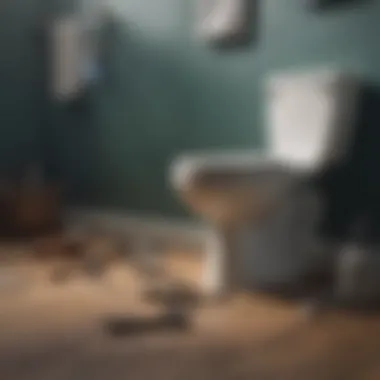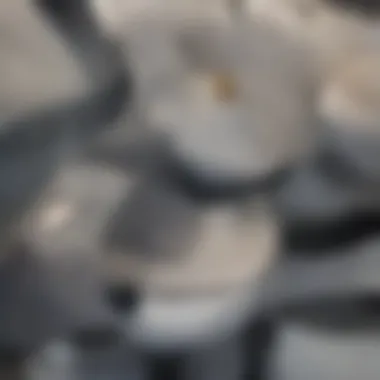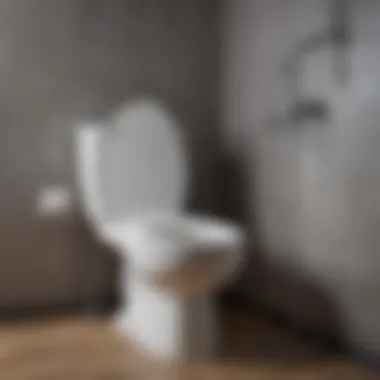How to Unclog a Toilet with a Wire Hanger


Intro
Understanding the plumbing system of a toilet can be quite beneficial for homeowners. When faced with minor clogs, knowing how to address these issues is invaluable. This article will focus on a practical method: using a wire hanger to snake a toilet. Many people may overlook this simple tool, but it can serve effectively when other solutions fail.
The guide is designed for those who want to learn a straightforward and cost-effective way to tackle toilet clogs. Whether you are a homeowner or just someone interested in home maintenance, the information here can be useful.
Necessary Tools and Preparation
Before engaging in the unclogging process, you will need some basic tools. Having the right items at your disposal can make the task smoother. Here are some things you may need:
- Wire Hanger: The main tool for this method. A standard metal hanger works best.
- Gloves: Protect your hands as you will handle potentially unsanitary materials.
- Bucket: To catch any excess water.
- Flashlight: A good light source can help you see inside the toilet.
Preparing the Hanger
To begin, straighten the wire hanger as much as possible but keep one end formed into a small hook. This hook will help in pulling the clog out. If your hanger is sturdy, it may be able to navigate through the toilet’s bends. Performing this preparation well is crucial to avoid damaging the toilet.
Steps to Unclog the Toilet
Once you have prepared your tools and hanger, follow these steps to unclog your toilet.
- Safety First: Put on your gloves. Ensure all necessary tools are within reach.
- Remove Excess Water: Use the bucket to remove excess water from the toilet bowl. This will give you better access to the blockage.
- Insert the Hanger: Carefully insert the bent end of the hanger into the toilet drain.
- Feel for the Clog: When you detect resistance, you are likely touching the clog. You can twist the hanger to try to break it up.
- Pull It Out: Once you feel you've either loosened or broken the clog, carefully pull the hanger out.
- Flush the Toilet: After removing the hanger, flush the toilet. Assess whether the problem is resolved.
- Try to navigate through any bends while gently pushing down.
- Be cautious. If you feel significant resistance, reassess the situation.
Safety Precautions
- Always wear gloves when working with plumbing. This prevents exposure to harmful bacteria.
- Avoid using excessive force. You may cause damage to the toilet’s internal components.
- Be mindful of what has been flushed down the toilet. Solid objects or excessive waste may cause more significant problems.
"Using a wire hanger can provide a practical solution to minor clogs. However, if the problem persists, consider consulting a professional."
Epilogue
In summary, unclogging a toilet with a wire hanger can be an efficient solution for minor clogs. By following the steps carefully, you can minimize damage and resolve issues without costly plumber fees. Mastering this skill not only empowers you as a homeowner but also enhances your confidence in handling home repairs.
While this method works for minor issues, remember that persistent problems may need professional attention. \A clean toilet is important for hygiene and peace of mind.
For further details on plumbing, you can check resources such as Wikipedia or Britannica for in-depth information.
Prelims to Toilet Clogs
Toilet clogs are more than just an inconvenience; they often signify underlying plumbing issues or user habits that need attention. Understanding the nature of toilet clogs is essential for homeowners, as it not only helps in effective management but also minimizes the likelihood of recurring problems. In this article, we will explore various aspects of toilet clogs, emphasizing practical solutions like using a wire hanger as a makeshift tool.
Understanding Common Causes of Clogs
Toilet clogs can arise from multiple sources. One of the most common reasons is the improper disposal of materials. Items like paper towels, feminine products, and excessive toilet paper can obstruct the drainage system. Other common culprits include foreign objects that accidentally fall into the toilet and accumulation of non-flushable waste.
Additionally, environmental factors such as hard water can lead to mineral buildup in pipes, reducing flow capacity and leading to clogs. Identifying these common causes can empower homeowners to make informed decisions about toilet maintenance and usage.
Identifying Signs of a Clogged Toilet


Recognizing the early signs of a clogged toilet can save time and prevent further complications. Some common indicators include:
- Slow drainage: If the toilet takes longer to empty than usual, it could be a sign of a developing clog.
- Gurgling sounds: Unusual noises coming from the toilet or pipes often signal a blockage.
- Backflow: Water rising towards the rim of the toilet bowl, rather than draining normally, is a clear hint.
"Prompt attention to these signs can mitigate more severe plumbing issues, reducing repair costs and frustrations."
Monitoring these signs and addressing them quickly contributes to maintaining a functional plumbing system in the home.
Preparing for the Task
Before attempting to unclog your toilet using a hanger, it is essential to prepare adequately. Preparation plays a vital role in ensuring a smooth process. When you gather the necessary tools and create a safe environment, you set the stage for effective problem-solving. This also prevents accidents or damage to your toilet, making the process more efficient.
Gathering Necessary Tools
To effectively snake a toilet with a hanger, you will need some crucial tools. Each of these items contributes to the overall goal: unclogging the toilet without causing further issues.
Wire Hanger
The wire hanger is the primary tool for this task. Its flexibility and length allow for easier access to clogs that are deeper in the toilet. A standard wire hanger can be adjusted to reach into the trap and maneuver around bends. Its key characteristic is the ability to be reshaped to fit the specific needs of the task. This adaptability makes it a popular choice for unclogging toilets. However, its thin profile can be a disadvantage, as it may not be effective against more solid blockages. Still, for minor clogs, a wire hanger is often sufficient.
Protective Gloves
Using protective gloves is crucial for personal safety. They act as a barrier between your skin and any unpleasant substances. This characteristic is particularly beneficial in bathroom tasks, where hygiene is important. Disposable rubber or latex gloves are a good choice because they are waterproof and provide good grip. Their unique feature is that they can be easily disposed of after use, reducing the risk of contamination. Wearing gloves can be viewed as an extra step; however, it significantly helps maintain sanitary conditions during the unclogging process.
Old Towels
Old towels serve as practical materials during the snaking process. They can be used to mop up any spills that may occur or to protect the floor around the toilet. The key characteristic of old towels is their absorbent quality, which is essential during messy tasks. They provide an effective way to keep the work area dry and clean. A unique advantage of using old towels is their availability; most households have a few that can be spared. However, it is important to choose towels that you do not mind potentially getting stained.
Creating a Safe Working Environment
Setting up a safe working environment is key when unclogging a toilet. This involves ensuring that the area is free from obstacles and that you have enough light to see what you are doing. Adequate lighting helps you perform the task effectively, reducing the chance of accidents. Clearing the surrounding area of any unnecessary items prevents tripping hazards and allows for easier movement.
In addition, wearing protective gear, especially if you have a weak stomach, can make the experience more manageable. Ensuring proper ventilation in the bathroom can also help reduce odors and keep the air fresh while you work.
Creating a Toilet Snake from a Hanger
Creating a toilet snake from a hanger is an essential step for anyone seeking to address a clogged toilet effectively. This method is resourceful, utilizing a common household item to tackle plumbing issues that can frustrate homeowners. Using a wire hanger provides flexibility and accessibility, two important attributes when trying to reach challenging blocks in the plumbing.
The importance of this section lies in the fact that often, standard tools such as plungers may not be readily available or may not be sufficient for particular clogs. A hanger, when properly transformed into a snake, can reach further and navigate complex bends in the plumbing system. This approach not only demonstrates ingenuity but also can save time and avoid unnecessary costs of calling a professional.
Selecting the Right Type of Hanger
The effectiveness of a toilet snake made from a hanger is dependent on the type of hanger used. The best choice often lies with a metal wire hanger, commonly found in closets. Metal wire hangers are sturdy and can withstand the pressure needed to dislodge clogs. Other types, such as plastic hangers, lack the necessary durability, which can lead to breakdown during usage.
When choosing a wire hanger, ensure that it is not too thick; a hanger that is overly rigid may not bend to reach intricate parts of the plumbing. Ideally, look for lightweight, flexible materials that can still exert necessary force to tackle stubborn blockages.
Shaping the Hanger into a Snake
Shaping the hanger into a snake is a fundamental process that involves two critical actions: straightening the hanger and bending the hook. Both of these steps are necessary for creating a tool that is effective at unclogging.
Straightening the Hanger


Straightening the hanger is an important process in creating a functional toilet snake. By removing the curves and bends typically found in hangers, you allow for easier access into the drain. Straightening the hanger not only enhances its reach but also increases the likelihood of navigating through tight spots in the plumbing system.
The key characteristic of straightening is that it prepares the wire to work effectively within the toilet. This step is a beneficial choice for creating the snake as it ensures that the tool is streamlined enough to slip past the toilet's siphon and into the trap. A straightened hanger can be guided down the toilet drain with more control, reducing the risk of clogs becoming further jammed.
Bending the Hook
Bending the hook of the hanger is equally crucial to the overall effectiveness of the toilet snake. The hook serves as the main tool to catch and dislodge clogs that may be sitting further down the line. By reshaping the hook, you create a more effective tool designed specifically for grabbing objects that may be causing blockages.
This step is significant because a properly bent hook can maneuver into the right position to snag difficult materials like toilet paper, foreign objects, or waste. A characteristic of this modification is that it adds versatility to the snake. However, it's important to maintain some tension in the wire; if the hook is too loose, it may fail to grasp anything effectively.
Remember: The balance between straight and bent parts of the hanger is essential for effective snaking.
Techniques for Snaking the Toilet
Understanding the right techniques for snaking a toilet is essential to effectively unclogging any blockages without causing damage to the plumbing system. Over time, various methods and tools can be utilized to manage a clogged toilet, with a wire hanger being a simple yet effective solution. This section focuses on the procedural elements that dictate how successfully one can maneuver the hanger, identify resistance, and address the clog with precision.
Inserting the Hanger into the Toilet Bowl
When you are ready to tackle the clog, begin by inserting the hanger into the toilet bowl. Angle the hanger so it can easily slip past the water surface. Being cautious during this step is important as improper insertion can lead to splashes. You want to insert gently, directing the hanger towards the trapway, which is where most blockages occur. The aim is to guide the hanger into the opening but not force it too quickly, as this might cause damage or push the clog further down.
Gently Maneuvering the Hanger
After inserting the hanger, you will need to maneuver it carefully within the toilet to break apart the clog. This requires a gentle touch, avoiding aggressive movements. Rotating and twisting the hanger can help dislodge whatever is causing the blockage. If you feel any obstruction, do not panic. Move slowly and steadily, allowing the hanger to work its way through. Be aware of your grip; maintaining control will help you avoid damaging the toilet's inner surfaces.
Identifying Resistance
As you work the hanger through the toilet, it is vital to understand how to identify resistance. If the hanger encounters a solid blockage, you will feel a firm stop. At this point, additional pressure might be necessary to break through tougher clogs. However, if you sense an unusual bend or if the hanger is not able to push through at all, it may suggest that you are applying too much force or hitting a curve. In such cases, withdrawal and reassessment are wise – consider adjusting the angle or using another approach. Noting where resistance occurs will help you determine the nature of the clog.
"Being patient during this process can often lead to a successful outcome. Know your limits with the hanger, and don’t hesitate to stop if resistance suggests a more serious problem."
Using these techniques, a wire hanger can be a surprisingly effective tool for managing minor toilet clogs. By maintaining a strategic approach, you can achieve unclogging with less frustration and risk of damage.
Safety Precautions to Consider
When dealing with toilet clogs, safety should not be overlooked. Engaging in any plumbing tasks entails certain risks that can lead to injuries or causing damage to your fixtures. As such, understanding safety precautions will help protect you and your plumbing system. Proper precautions ensure that you minimize hazards while achieving effective results.
Avoiding Damage to Toilet Fixtures
One of the primary concerns when using a wire hanger to unclog a toilet is the potential for damaging the toilet's porcelain or seals. Toilets, while sturdy, can chip or crack if mechanical force is applied improperly. Here are some strategies to avoid such issues:
- Gentle Insertion: Always insert the hanger slowly and with care. Forceful entry can lead to cracks.
- Avoid Sharp Edges: If the hanger ends are jagged or rough, smooth them down to prevent scratching the toilet's inner surface.
- Be Mindful of Angles: Instead of pushing down with great force, try to angle the hanger so it follows the curves of the plumbing. This approach reduces the risk of damaging the bowl or pipes.
Keeping these preventative measures in mind can prolong the life of your toilet and save you from costly repairs.
Personal Protective Equipment
Using a wire hanger to clear a clog can be messy. Therefore, the right personal protective equipment is essential to safeguard yourself from potential health hazards.
- Protective Gloves: Always wear durable latex or nitrile gloves when handling the hanger. This protects your hands from bacteria and harmful substances that may be present.
- Eye Protection: Although not a common occurrence, splashes from the toilet can happen while clearing a clog. Use safety goggles to shield your eyes from any unforeseen debris.
- Clothing Protection: Wear old clothes or an apron that you don’t mind getting dirty. This way, if splashes occur, you will not ruin your favorite attire.
By following these safety measures, you can approach the task with more confidence, knowing you’re protected from potential risks. The goal is to make sure your DIY efforts are both effective and safe.


"Safety first. Always protect yourself when tackling plumbing issues at home."
After the Snaking Process
The aftermath of using a wire hanger to snake your toilet is critical. Successfully clearing a clog is just one part of the equation; you must ensure proper functionality before you can consider the task complete. The following sections will guide you through the essential steps for checking your toilet's performance and cleaning your workspace.
Testing the Toilet's Functionality
Once you have completed the snaking process, the first thing to do is test the toilet's functionality. This step is not just about verifying that the clog is gone. It encompasses ensuring that the toilet flushes effectively and that there are no leaks. To begin, refill the toilet tank by flushing it once. Pay attention to how well it flushes. Here are some points to consider:
- Flush Quality: Observe if the toilet flushes quickly and forcefully. If it does, you may have effectively removed the obstruction.
- Unexpected Noises: Listen for any gurgling sounds which could suggest incomplete clog removal or further issues.
- Water Level: Check the water level in the toilet bowl after flushing. A significant drop or no rise could indicate problems.
If the toilet does not perform as expected, you might need to repeat the snaking process or explore other avenues, possibly indicating that the clog is more severe than initially thought.
Cleaning Up the Work Area
After ensuring the toilet is functioning properly, it's time to address the consequences of your efforts. Cleaning up the work area is just as crucial as the unblocking process itself. A tidy environment helps to minimize lingering odors and prevents any health hazards. Here are several steps to follow:
- Dispose of Waste: Safely dispose of any materials used during the snaking. This includes knocking off waste from the hanger, along with any old towels or protective gloves you utilized.
- Sanitize the Surrounding Area: Use an appropriate cleaner to wipe down all surfaces that could have come in contact with the toilet bowl water. This includes the floor around the toilet, as splashes may occur during the process.
- Inspect and Restock Tools: Finally, inspect your tools to ensure they are clean and in good condition for future use. Consider keeping gloves and towels near your cleaning supplies for immediate accessibility next time.
A clean workspace not only promotes hygiene but also brings a sense of accomplishment to your DIY project.
Following these steps aids in creating a safe and pleasant bathroom environment, reinforcing that effective unclogging goes hand-in-hand with cleanliness.
When to Call a Professional
While many clogs can be resolved using a wire hanger, it is crucial to recognize the limits of this method. Knowing when to call a professional plumber can save both time and additional expense. Engaging a professional ensures that the underlying issues are addressed effectively, preventing repeat inconveniences. This section elaborates on specific signs that indicate the need for expert intervention, as well as long-term solutions that can preempt future plumbing problems.
Signs that a Clog Requires Expert Attention
Sometimes, clogs can signal more serious problems within the plumbing system. Here are several indicators that suggest it's time to call a professional:
- Persistent Clogs: If after several attempts with the hanger the clog remains, it may indicate a deeper issue that needs specialized tools.
- Multiple Fixtures Involved: When more than one toilet or drain in the house produce problems simultaneously, it may point to a blockage in the main sewer line.
- Foul Odors: A strong sewage smell in or around the home can be a sign of a serious clog or a broken sewer line.
- Gurgling Noises: If you hear gurgling sounds in pipes after flushing, it may mean air pressure issues or a blockage that requires professional assessment.
"Ignoring persistent plumbing issues can lead to bigger problems down the road. Always err on the side of caution."
These signs are indicators that you should consider investing in professional help to avoid property damage and extensive repair costs.
Long-Term Solutions to Consider
Preventive measures are key to maintaining a healthy plumbing system. While snaking a toilet can be a satisfactory short-term solution, consider these long-term strategies to minimize future issues:
- Regular Maintenance: Schedule periodic check-ups with a plumber to inspect your system. This proactive approach can catch problems before they escalate.
- Proper Waste Disposal: Be mindful of what goes down the toilet. Items like wipes, feminine products, and excessive paper towels can cause major drains to clog.
- Install a Drain Screen: For toilets and sinks, screens can capture debris before it enters the plumbing, helping to keep pipes clear.
- Upgrade Plumbing: If you have outdated pipes, consider upgrading them. Modern plumbing materials can reduce the likelihood of blockages.
Investing in these solutions can enhance the longevity of your plumbing and reduce instances requiring emergency interventions.
Epilogue
In the realm of home maintenance, understanding the fundamentals of unclogging a toilet proves essential. This article has delved into the practical method of using a wire hanger, empowering homeowners to handle minor clogs with greater confidence. By mastering this technique, individuals can save both time and resources. Often, a simple blockage can wreak havoc, disrupting daily routines. Realizing that there are effective DIY methods encourages a proactive approach to home care.
Recap of Key Points
- Understanding Clogs: Recognizing common causes and signs aids in identifying the problem before it escalates.
- Preparation: Gathering the necessary tools, like a wire hanger and protective gloves, sets the stage for a successful unclogging attempt.
- Techniques: Knowing how to shape and maneuver the hanger is crucial for effectively breaking up blockages without damaging the toilet.
- Safety Precautions: It is vital to equip oneself with proper protective gear to prevent injuries or contamination.
- When to Seek Help: Recognizing the limits of DIY is important. Not all clogs can be resolved without professional assistance.
Encouragement for DIY Efforts
Homeowners should not shy away from tackling minor plumbing issues themselves. Embracing the DIY spirit promotes self-sufficiency. Unclogging toilets using a simple wire hanger is an example where you do not need extensive plumbing knowledge. With methodical preparation and following the guidelines outlined, individuals can handle a common household annoyance. Engaging in such tasks increases familiarity with household systems, leading to a more profound understanding of home maintenance.
Using readily available tools encourages creativity and problem-solving skills. Small projects can lead to larger successes, fostering confidence in managing home repairs. For more ideas and discussions, communities on platforms like reddit.com offer valuable insights for DIY enthusiasts.



